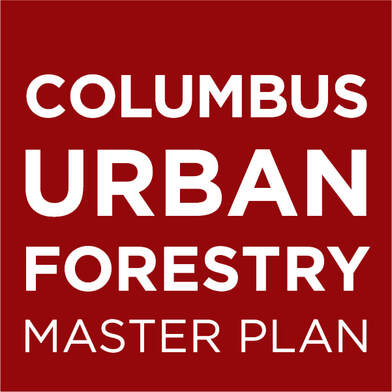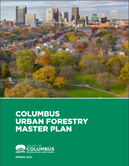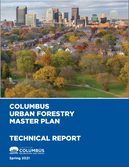|
The Urban Forestry Master Plan (UFMP) is a strategic and long-term investment in Columbus’ tree canopy. An urban forest refers to all the trees within a city, across all lands (both public and private). Why is our tree canopy important? Tree canopy reduces the heat island effect, reduces air pollution, intercepts stormwater, improves quality of life and so much more. Our tree canopy is vulnerable to threats from disease, pests, the changing climate and increased development. Columbus is expecting 1 million more residents by 2050. Efforts like the Urban Forestry Master Plan need to happen now to ensure residents’ quality of life in the coming decades. The Urban Forestry Master Plan is for the entire community — both public and private landowners. It will take every resident and business owner’s involvement to move the needle on this transformational plan. What is the Urban Forestry Master Plan? The Columbus Urban Forestry Master Plan (UFMP) is the first Citywide, strategic plan to invest long-term in Columbus’ trees. Over the next decades, the UFMP will guide the entire Columbus community to prioritize, preserve and grow our tree canopy. What is an urban forest, and where does it grow? An urban forest is simply a term that refers to all trees within a city, across all lands (both public and private). It is important to manage the entire forest because natural systems do not distinguish between property boundaries. In Columbus, 70% of our trees grow on private property, such as residential property, businesses and industrial areas. The other 30% grow on public property, such as streets and parks. What is tree canopy? Or canopy cover? Tree canopy refers to the part of a city that is shaded by trees. Canopy cover is the percentage of the city that is covered by trees when viewed from above, as opposed to other land cover like water, open green space, hard surfaces and bare soil. In Columbus, 22% of the city is covered by trees. Why does Columbus need an Urban Forestry Master Plan? Columbus faces many challenges today and over the coming decades, and trees are part of the solution. Trees help reduce urban stressors — cleaning our air, providing shade, intercepting stormwater and more. The benefits urban trees provide is valued up to five times what it costs to maintain them. In Columbus, our trees provide $38 million in benefits each year. However, our tree canopy is vulnerable to threats from disease, pests, the changing climate and increased development. Also, the City is expecting to grow by 1 million residents in the coming decades. To improve our residents’ quality of life, we needed a strategic plan to invest in our trees. To learn more about the benefits trees provide, see Chapter 2: Trees as a Solution. |
Read the planAdopted in April 2021, the UFMP process produced two documents: the UFMP itself, and an accompanying Technical Report, both linked below. Plan highlights can be found here.
The Latest2011-2021 Tree Canopy Assessment Report Now Available. The City of Columbus and Franklin County just released a comprehensive report on the regions trees and change in canopy cover over time. Learn more and view the report.
Public Tree Code Adopted! We are happy to announce that the City's new Public Tree Code has passed! Next up, improvements to tree protection regulations during development.
Ongoing. UFMP Implementation Progress Updates Available. Updates are available on the Urban Forestry Master Plan (UFMP) progress made to-date.
|
When did the process start to create the Urban Forestry Master Plan?
A 2015 Urban Tree Canopy Assessment found that 22% of Columbus is covered with trees and recommended a strategic plan to grow tree canopy. The process to create the Urban Forestry Master Plan officially started in October 2019.
Who was involved in creating the Urban Forestry Master Plan?
Hundreds of stakeholders helped create the Urban Forestry Master Plan. Industry experts, universities, nonprofits, developers, community leaders, city staff and leadership, regional partners, landscape architects and many others served on two stakeholder groups: a Project Team of about 30 members and an Advisory Group of about 100 members. All members are listed in the Acknowledgments section of the UFMP and on the website. These groups met periodically throughout the course of the plan’s creation to provide input. The public was also engaged through an online survey, an open house, small-group presentations and interviews.
How was the public involved in this plan?
We engaged residents across Columbus through five avenues: an online survey, an open house, small-group presentations, interviews and multiple meetings of two stakeholder groups comprised of over 100 community leaders and city staff. The themes that emerged were used to develop the vision, goals and actions of the Urban Forestry Master Plan. To learn more about the public input process and what we learned, see Chapter 3: The Community Weighs In.
What is the vision of the Urban Forestry Master Plan?
To prioritize, preserve and grow the tree canopy in Columbus, equitably across neighborhoods, to improve health and quality of life for all residents.
What are the goals of the Urban Forestry Master Plan?
The Urban Forestry Master Plan has three goals. One is long-term, and the other two are short-term. All are critical to achieving our vision for Columbus’ urban forest.
What does equity mean when it comes to the urban forest?
Trees are vital infrastructure that every neighborhood deserves. However, historic disinvestment, land use patterns, zoning and other factors mean that Columbus’ tree canopy varies widely across the city. An equitable tree canopy is mature, healthy and sustainable, and it is appropriately placed to provide other environmental and social benefits in neighborhoods.
In order to create an equitable tree canopy in Columbus, both canopy cover and social equity factors will be used to prioritize neighborhoods for investment. Investment in these neighborhoods goes beyond planting trees and will also entail collecting data on the existing urban forest, caring for and preserving mature trees, and improving public safety by removing hazardous trees.
What are the strategies the Urban Forestry Master Plan recommends?
To reach our goals, we will follow four strategies: community coordination and collaboration; best practices, dedication of resources and stronger policies. See Chapter 6: The Action Plan for more details.
When did implementation start?
The Columbus Recreation and Parks Commission and Columbus City Council voted unanimously to support the Urban Forestry Master Plan in April 2021. With the support of the Mayor’s Office, the implementation phase started in May 2021.
A 2015 Urban Tree Canopy Assessment found that 22% of Columbus is covered with trees and recommended a strategic plan to grow tree canopy. The process to create the Urban Forestry Master Plan officially started in October 2019.
Who was involved in creating the Urban Forestry Master Plan?
Hundreds of stakeholders helped create the Urban Forestry Master Plan. Industry experts, universities, nonprofits, developers, community leaders, city staff and leadership, regional partners, landscape architects and many others served on two stakeholder groups: a Project Team of about 30 members and an Advisory Group of about 100 members. All members are listed in the Acknowledgments section of the UFMP and on the website. These groups met periodically throughout the course of the plan’s creation to provide input. The public was also engaged through an online survey, an open house, small-group presentations and interviews.
How was the public involved in this plan?
We engaged residents across Columbus through five avenues: an online survey, an open house, small-group presentations, interviews and multiple meetings of two stakeholder groups comprised of over 100 community leaders and city staff. The themes that emerged were used to develop the vision, goals and actions of the Urban Forestry Master Plan. To learn more about the public input process and what we learned, see Chapter 3: The Community Weighs In.
What is the vision of the Urban Forestry Master Plan?
To prioritize, preserve and grow the tree canopy in Columbus, equitably across neighborhoods, to improve health and quality of life for all residents.
What are the goals of the Urban Forestry Master Plan?
The Urban Forestry Master Plan has three goals. One is long-term, and the other two are short-term. All are critical to achieving our vision for Columbus’ urban forest.
- Goal 1: Reach Citywide Tree Canopy Cover of 40%.
- Goal 2: Stop the Net Canopy Losses by 2030.
- Goal 3: Invest in Equitable Canopy Across All Neighborhoods by 2030.
What does equity mean when it comes to the urban forest?
Trees are vital infrastructure that every neighborhood deserves. However, historic disinvestment, land use patterns, zoning and other factors mean that Columbus’ tree canopy varies widely across the city. An equitable tree canopy is mature, healthy and sustainable, and it is appropriately placed to provide other environmental and social benefits in neighborhoods.
In order to create an equitable tree canopy in Columbus, both canopy cover and social equity factors will be used to prioritize neighborhoods for investment. Investment in these neighborhoods goes beyond planting trees and will also entail collecting data on the existing urban forest, caring for and preserving mature trees, and improving public safety by removing hazardous trees.
What are the strategies the Urban Forestry Master Plan recommends?
To reach our goals, we will follow four strategies: community coordination and collaboration; best practices, dedication of resources and stronger policies. See Chapter 6: The Action Plan for more details.
When did implementation start?
The Columbus Recreation and Parks Commission and Columbus City Council voted unanimously to support the Urban Forestry Master Plan in April 2021. With the support of the Mayor’s Office, the implementation phase started in May 2021.



